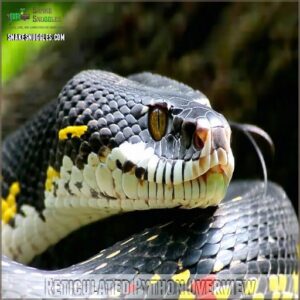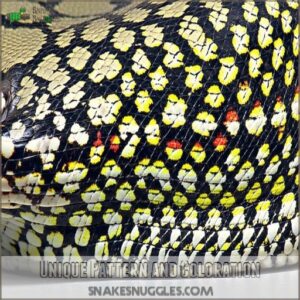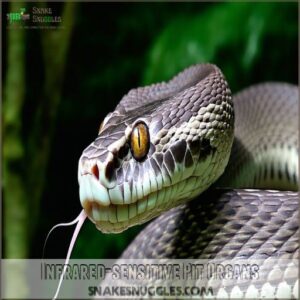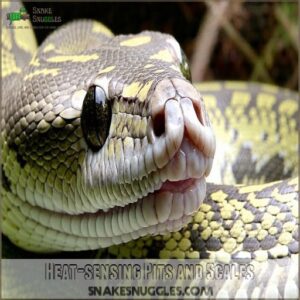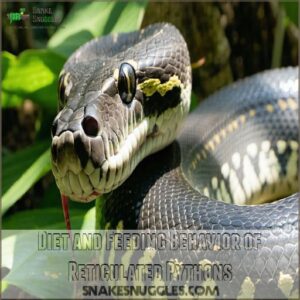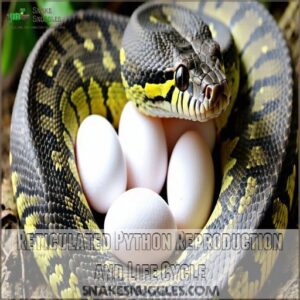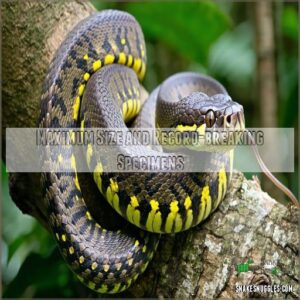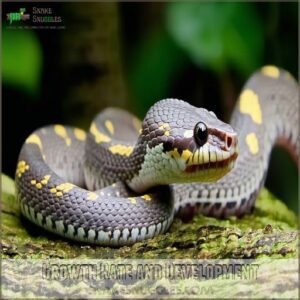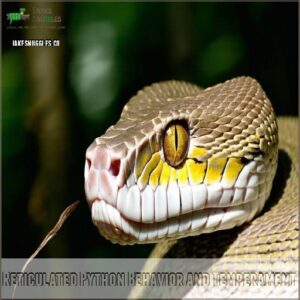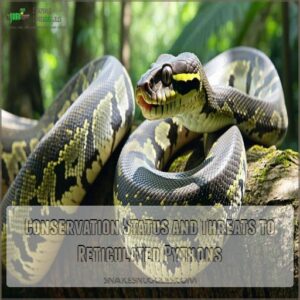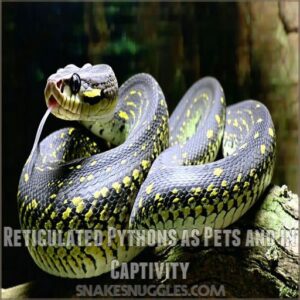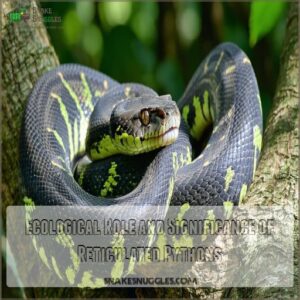This site is supported by our readers. We may earn a commission, at no cost to you, if you purchase through links.
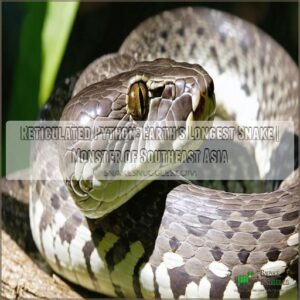 You’re looking at nature’s longest snake – the reticulated python can stretch up to a whopping 33 feet, about the length of a school bus!
You’re looking at nature’s longest snake – the reticulated python can stretch up to a whopping 33 feet, about the length of a school bus!
These impressive constrictors call Southeast Asia’s rainforests home, where they’re easily spotted by their distinctive net-like pattern (that’s where the "reticulated" name comes from).
They’ve got some pretty neat tricks up their scales, including heat-sensing pits that help them detect warm-blooded prey in total darkness.
While they might seem intimidating, these remarkable reptiles play a significant role in controlling rodent populations and maintaining forest health.
Understanding their behavior reveals fascinating survival strategies that have helped them thrive for millions of years.
Table Of Contents
- Key Takeaways
- Reticulated Python Overview
- What Makes a Python Reticulated
- Reticulated Python Habitat and Distribution
- Diet and Feeding Behavior of Reticulated Pythons
- Reticulated Python Reproduction and Life Cycle
- Reticulated Python Size and Growth
- Reticulated Python Behavior and Temperament
- Conservation Status and Threats to Reticulated Pythons
- Reticulated Pythons as Pets and in Captivity
- Ecological Role and Significance of Reticulated Pythons
- Frequently Asked Questions (FAQs)
- What makes a python reticulated?
- Has a reticulated python ever killed a human?
- What eats reticulated pythons?
- Is a reticulated python a good pet?
- How fast can a reticulated python move?
- What diseases commonly affect reticulated pythons?
- How long do reticulated pythons live?
- Can reticulated pythons recognize their owners?
- Do reticulated pythons hibernate during winter months?
- Conclusion
Key Takeaways
- You’ll find reticulated pythons stretching up to 33 feet long, making them one of the largest species of snakes that can be found in various habitats, including rainforests and human settlements, making them Earth’s longest snake species with distinctive net-like patterns of black, white, yellow, and red scales.
- These skilled hunters use heat-sensing pits along their jaws to detect warm-blooded prey in darkness, helping them maintain their role as apex predators in Southeast Asia’s ecosystems.
- They’re highly adaptable snakes that thrive in diverse environments from dense rainforests to urban areas, though they face ongoing threats from habitat loss and illegal trading.
- While they can live 20-30 years in captivity, they’re not suitable as pets due to their massive size, strength, and specific care requirements including at least a 20-foot enclosure.
Reticulated Python Overview
Ball pythons, which share some habitats with the reticulated python in the tropical regions of Africa, inhabit savanna grasslands and open forests, often taking shelter in abandoned mammal burrows. You’ll find the reticulated python (Malayopython reticulatus) stretching up to 32 feet long, making it Earth’s longest snake species and a fascinating member of the python family.
When you encounter this remarkable reptile in Southeast Asia’s diverse landscapes, you’ll notice its distinctive pattern of complex geometric shapes made up of black, white, yellow, and red scales covering its massive body.
Scientific Classification and Taxonomy
You might be surprised to learn that the reticulated python, Malayopython reticulatus, recently got a name makeover.
Originally classified as Python reticulatus, genetic studies in 2014 revealed it needed its own genus.
Scientists now recognize three distinct subspecies: M. reticulatus jampeanus, M. reticulatus reticulatus, and M. reticulatus saputrai, all belonging to the Pythonidae family of constricting snakes.
Physical Characteristics and Features
The reticulated python’s striking appearance sets it apart in the Pythonidae family.
Nature equipped these magnificent constrictors with:
- Distinctive diamond-shaped patterns in black, white, and yellow
- Heat-sensing pits along their jaws for detecting prey
- Orange eyes with vertical pupils for enhanced night vision
You can find a variety of products inspired by these Reticulated Python markings online.
Their streamlined body shape, covered in smooth scales, lets them move effortlessly through Southeast Asian rainforests, making them perfectly adapted predators.
What Makes a Python Reticulated
You’ll recognize a reticulated python by its distinctive net-like pattern of scales that form complex geometric shapes in black, white, yellow, and red across its body.
You can also spot this remarkable snake by the heat-sensing pits along its jaws, which help it detect warm-blooded prey even in complete darkness.
Unique Pattern and Coloration
Intricate networks of dark geometric shapes, resembling a complex net, give reticulated pythons their distinctive name and appearance.
You’ll notice their bodies showcase a stunning mosaic of black, white, yellow, and red scales forming X- or diamond-shaped blotches against a grayish-tan background.
This natural camouflage helps them blend seamlessly into their forest habitat, providing an evolutionary advantage when hunting or avoiding predators.
Infrared-sensitive Pit Organs
Beyond their mesmerizing patterns, reticulated pythons possess remarkable infrared-sensitive pit organs.
These organs act like built-in night vision goggles, detecting subtle temperature differences in their environment.
When hunting in complete darkness, they’ll sense warm-blooded prey from several feet away, giving them a serious edge over other predators in their Southeast Asian habitat.
They utilize pit viper heat sensing, a specialized adaptation that’s evolved over millions of years.
Heat-sensing Pits and Scales
Remarkable heat-sensing pits line your reticulated python’s lips, acting like built-in thermal cameras.
You’ll find these specialized organs nestled between the scales, detecting even the slightest temperature changes from warm-blooded prey.
Each pit connects to highly sensitive nerves, giving these ambush predators an edge in low-light conditions.
Think of them as nature’s night-vision goggles, helping pythons locate prey with pinpoint accuracy.
Reticulated Python Habitat and Distribution
You’ll find these massive snakes throughout Southeast Asia’s diverse landscapes, from the dense rainforests of Indonesia to the urban areas of Singapore.
In their native range, they’ve adapted to various environments including woodlands, grasslands, and even human-modified habitats where they can swim in waterways and climb trees with surprising agility.
Native Range in Southeast Asia
You’ll find these magnificent serpents throughout Southeast Asia’s diverse landscapes.
Reticulated pythons (Python reticulatus) have adapted to various environments.
From the dense rainforests of Indonesia and Malaysia to the coastal mangroves of Thailand and the Philippines, they thrive in tropical and subtropical zones, making their homes in lowland forests, wetlands, and even agricultural areas where prey is abundant and cover is plentiful.
Introduced Populations and Geographic Range
While native to Southeast Asia’s lush landscapes, reticulated pythons have established populations in several new locations.
They’ve been spotted in Florida’s Everglades, Puerto Rico, and parts of Indonesia where they weren’t historically present.
These introductions often stem from escaped or released pets.
In Florida alone, wildlife officials have documented over 50 confirmed sightings since 2000, raising concerns about their impact on local wildlife.
Habitat Requirements and Adaptability
Inside Southeast Asia’s lush landscapes, reticulated pythons showcase remarkable adaptability across diverse environments.
These versatile hunters thrive in:
- Dense tropical rainforests with high humidity
- Urban areas, including drainage systems and abandoned buildings
- Agricultural landscapes where prey is abundant
- Coastal mangroves and wetland ecosystems
Despite habitat loss threatening their natural domains, these resourceful snakes have proven surprisingly adaptable to human environments, making them one of nature’s most resilient species.
Diet and Feeding Behavior of Reticulated Pythons
You’ll find that reticulated pythons are skilled hunters who use heat-sensing pits to detect prey before grabbing it with their sharp, backward-facing teeth.
After seizing their prey, which ranges from birds to deer, they’ll coil around it and squeeze tighter with each exhale until the animal suffocates.
Wild Diet and Prey
Reticulated pythons are opportunistic ambush predators in tropical rainforests, targeting whatever prey they can overpower.
Like many snakes, they’re carnivorous creatures that cannot digest plants and require high-calorie foods to fuel their energy.
Your typical retic hunts mammals like wild pigs, deer, and primates, but they’ll also snag birds and reptiles when available.
As seasons change, so does their diet – they’ll adapt to whatever’s abundant.
These skilled hunters use their remarkable heat-sensing pits to detect prey, making them effective nighttime predators.
Zoo Diet and Feeding in Captivity
Typically, zoos feed their reticulated pythons a diet based on their age and dimensions, with adult retics requiring substantial rodents such as rabbits for reticulated pythons, which are usually provided every 2-4 weeks.
You can find a wide variety of feeding supplies for these magnificent creatures.
You’ll notice that keepers carefully monitor each snake’s weight and adjust portions accordingly.
They’ll also provide enrichment items during feeding to stimulate natural behaviors.
In warmer months, you might see increased appetite, while winter brings reduced feeding frequency – mimicking their wild patterns.
Hunting and Ambushing Techniques
Moving from feeding patterns in zoos, let’s see how these stunning snakes hunt in nature.
You’ll find reticulated pythons are masters of the ambush, using their exceptional camouflage to vanish into their surroundings.
Their hunting success relies on three key abilities:
- Lightning-fast strikes that can reach speeds of 1 meter per second
- Heat-sensing pits that detect warm-blooded prey in darkness
- Powerful constriction that can stop a deer’s heart in minutes
Reticulated Python Reproduction and Life Cycle
You’ll find that reticulated pythons are remarkable breeders, with females laying up to 100 eggs every two to four years during the warmer months.
During breeding season, you can observe males creating vibrations to attract females, who’ll then coil around their eggs and warm them through a fascinating behavior called shivering until they hatch.
Breeding and Mating Habits
During the warmer months, these massive snakes engage in fascinating mating rituals.
You’ll find females releasing pheromones that act like a love potion, attracting males from impressive distances.
The dating game gets competitive as males travel far and wide to find their potential mates.
What’s truly remarkable is that females don’t settle for just one partner – they’re polyandrous, mating with several males during breeding season.
Egg-laying and Incubation
Female reticulated pythons lay impressive clutches of 20-50 eggs, with some exceptional mothers producing over 100 eggs at once.
You’ll find these dedicated moms coiled tightly around their precious eggs for 80-90 days, using muscle contractions to generate warmth – nature’s perfect incubator.
Once the baby pythons emerge, though, they’re on their own – mom’s job is done.
Lifespan and Sexual Maturity
The journey to adulthood for a reticulated python involves distinct growth milestones.
You’ll find these giants of the snake world reaching sexual maturity between 2-4 years old, with females typically maturing later than males.
Here’s what shapes their life journey:
- Males reach breeding age at 2-3 years
- Females become sexually mature at 3-4 years
- Average lifespan spans 20-25 years in the wild
Reticulated Python Size and Growth
Ball pythons, known for coiling into defense balls for protection, are also a popular pet snake species, which can be researched further at Ball Python Facts. You’ll find that reticulated pythons reach lengths of up to 32 feet, making them the longest living snake species on Earth.
While most reticulated pythons measure less than 16 feet and weigh between 165 and 386 pounds, females consistently grow larger than males, with some exceptional specimens surpassing these typical measurements.
Average Length and Weight
Adult reticulated pythons, which are native to the rainforests and swamps of Southeast Asia, typically reach lengths of 10-16 feet, with females growing significantly larger than males.
You’ll find most adults weighing between 75-175 kg (165-386 pounds), though their size varies based on diet and habitat.
Those interested in learning more about reticulated python size can find various products and accessories online for reference, such as at reticulated python size accessories.
Males mature at smaller sizes, usually 7-9 feet long.
These impressive measurements make them substantial predators in their Southeast Asian ecosystems, though they’re not the giants of legend.
Maximum Size and Record-breaking Specimens
Record-breaking reticulated pythons have stretched the limits of what we thought possible for snake size.
While most retics reach impressive lengths of 16-20 feet, truly exceptional specimens have been documented at over 25 feet.
Nonetheless, for such massive snakes, it’s important to research safe enclosure environments, including adequate space and humidity, as detailed in guides for owning the largest snake that you can own Handling Large Snakes Safely.
The largest verified specimen was 28.5 feet long, discovered in Indonesia in 1912.
You’ll find regular claims of longer pythons, but most lack proper documentation and scientific verification.
Growth Rate and Development
Most reticulated pythons start life at just two feet long, but you’ll be amazed at how quickly they develop.
These impressive snakes grow rapidly through their juvenile stage, reaching maturity in 2-4 years.
- Hatchlings emerge at 24-30 inches and triple their size in the first year
- Growth rate depends heavily on food availability and environmental conditions
- Females typically grow faster and larger than males
- Ideal temperatures of 85-90°F accelerate development
Reticulated Python Behavior and Temperament
You’ll find reticulated pythons living solitary lives, staying hidden during daylight and emerging at night to hunt their prey using their remarkable heat-sensing abilities.
While they’re naturally shy around humans, these massive snakes will defend themselves if they feel threatened, using their impressive size and strength to intimidate potential predators.
Nocturnal and Solitary Behavior
Reticulated pythons prowl the darkness, living a mysterious solo life in Southeast Asia’s dense jungles. You’ll find these remarkable snakes most active after sunset, when they emerge to hunt using their incredible heat-sensing abilities.
| Behavior Pattern | Day | Night |
|---|---|---|
| Activity Level | Low | High |
| Hunting | Rare | Frequent |
| Movement | Limited | Extensive |
| Social Contact | None | None |
| Territory Marking | Minimal | Active |
These solitary hunters prefer their own company, crossing paths with others only during breeding season.
Aggression and Defense Mechanisms
These giants aren’t typically aggressive, but they’ve got an impressive arsenal of defense moves.
When threatened, they’ll inflate their bodies while producing loud hissing sounds to appear larger and more intimidating.
Their primary defense includes rapid defensive strikes, followed by powerful tail whips.
If these warnings fail, they’ll retreat using their incredible camouflage to blend seamlessly into their surroundings.
Interaction With Humans and Pets
In urban areas, your encounters with reticulated pythons might be more common than you’d think.
While these giants typically avoid human contact, they’ll occasionally venture into residential zones searching for pets.
They’ve been known to take cats, dogs, and livestock, though attacks on humans remain extremely rare.
If you spot one, it’s best to keep your distance and contact local wildlife authorities.
Conservation Status and Threats to Reticulated Pythons
You’ll find reticulated pythons listed as a species of least concern by the IUCN, though they face ongoing challenges from illegal trading and habitat destruction.
Reticulated pythons can survive in urban environments.
While these adaptable snakes can survive in urban environments, their striking patterns and massive size make them targets for poachers who sell them in international markets.
IUCN Classification and Status
Despite their impressive adaptability, you’ll find reticulated pythons listed under "Least Concern" on IUCN’s Red List.
While their population remains stable across Southeast Asia, population monitoring shows concerning local declines in some regions.
Conservation efforts focus on regulating international trade through CITES agreements, which help protect these magnificent constrictors from over-exploitation.
Local protection laws vary considerably between countries, creating challenges for unified conservation strategies.
Habitat Loss and Human Activities
While reticulated pythons maintain a stable conservation status, their world’s getting smaller by the day.
You’ll find their habitats shrinking as urban development, palm oil plantations, and logging operations carve up Southeast Asia’s forests.
These giants face new challenges adapting to fragmented landscapes, often forcing them into uncomfortable encounters with humans in residential areas.
Local communities and conservationists are working to find sustainable solutions for coexistence.
Poaching and Illegal Trade
Beyond habitat destruction, poaching poses a serious threat to reticulated pythons.
You’ll find their distinctive skins appearing in luxury fashion markets worldwide, where a single hide can fetch thousands of dollars.
The exotic pet trade also drives illegal collection, with smugglers targeting both adults and eggs.
Reputable breeders specializing in captive bred snakes can help mitigate these threats.
Conservation efforts focus on strengthening international trade regulations and supporting local communities in protecting these remarkable creatures.
Reticulated Pythons as Pets and in Captivity
You’ll need a specialized setup with precise temperature control and at least a 20-foot enclosure to keep a reticulated python as a pet.
While these impressive snakes can make fascinating captive animals, they’re not suitable for most people due to their massive size, strength, and specific care requirements that include regular feeding of large prey items.
Care Requirements and Housing
Properly housing a reticulated python requires careful attention to detail.
You’ll need a secure, custom-built enclosure that’s at least 1.5 times the snake’s length and 4 feet wide.
Maintain temperatures between 85-90°F with a basking spot of 95°F, and humidity levels at 60-80%.
The substrate should be moisture-retaining materials like cypress mulch, and provide branches and hiding spots for enrichment.
Feeding and Handling in Captivity
Feeding a captive reticulated python requires careful planning and strict safety protocols, similar to feeding a blood python, which demands a varied diet including small mammals and reptiles. Feeding a captive reticulated python requires careful planning and strict safety protocols.
You’ll need to provide appropriately-sized prey items like rats or rabbits, depending on your python’s size.
Never handle your python alone or during feeding time, and always use proper support techniques when moving these powerful constrictors.
Regular feeding schedules and consistent handling help maintain their docile nature in captivity.
Laws and Regulations Regarding Ownership
Laws governing reticulated python ownership vary widely across regions.
You’ll need specific permits in most U.S. states, while some countries completely ban these giants as pets.
In the United States, approximately 20 states permit venomous snake ownership with a state permit for venomous snakes.
Check your local regulations carefully – they often require proof of secure housing, experience handling large constrictors, and emergency protocols.
CITES regulations also control international trade to protect wild populations from exploitation.
Ecological Role and Significance of Reticulated Pythons
You’ll find reticulated pythons at the top of Southeast Asia’s food chain, where they regulate populations of deer, pigs, and other mammals through their role as apex predators.
As these adaptable giants establish themselves in both wild habitats and urban areas, they’re proving their remarkable ability to maintain ecological balance across diverse environments.
Apex Predator and Ecological Balance
The giant reticulated python stands as Southeast Asia’s supreme apex predator, orchestrating a delicate ecological balance across diverse ecosystems.
You’ll find these remarkable serpents maintaining ecosystem health through:
- Controlling invasive species populations
- Preventing disease spread among prey animals
- Supporting forest regeneration through seed dispersal by prey
- Maintaining biodiversity by preventing single-species dominance
Their presence signals a healthy, functioning ecosystem where predator-prey relationships thrive naturally.
Prey Regulation and Population Control
Majestic reticulated pythons play a key role in maintaining Southeast Asia’s delicate ecosystem balance through prey regulation.
They’re nature’s population control experts, keeping various species in check.
Here’s how they impact different prey populations:
| Species Type | Population Impact | Ecological Benefit |
|---|---|---|
| Rodents | High control | Disease reduction |
| Small mammals | Moderate control | Forest regeneration |
| Birds | Selective control | Habitat balance |
| Wild pigs | Limited control | Vegetation protection |
| Deer | Occasional control | Understory maintenance |
Adaptation and Resilience in Human-dominated Landscapes
Despite increasing urban development, you’ll find reticulated pythons showing remarkable adaptability in human-dominated landscapes.
These resilient giants have learned to navigate fragmented habitats, from city sewers to agricultural fields.
While this adaptation brings occasional human-wildlife conflict, it’s also a strong indicator of their survival skills.
They’ve mastered living alongside us, proving that even Earth’s longest snake can thrive in our changing world.
Frequently Asked Questions (FAQs)
What makes a python reticulated?
Distinctive scale patterns on your reticulated python create complex networks resembling a net or web across their body.
These intricate geometric designs, featuring black lines with lighter centers, give them their "reticulated" name.
Has a reticulated python ever killed a human?
Yes, reticulated pythons have been documented to kill humans, though it’s rare.
These incidents typically occur when humans encounter pythons in remote areas.
In 2017, a 25-foot python killed and swallowed an Indonesian farmer.
What eats reticulated pythons?
In a world where they’re nearly invincible, you’ll find king cobras, crocodiles, and monitor lizards preying on young reticulated pythons.
Adult pythons face few threats except humans, who hunt them for skin and meat.
Is a reticulated python a good pet?
Reticulated pythons don’t make suitable pets for most people.
They’re massive, requiring extensive space and expertise.
Their size and strength pose significant risks, and they need specialized care that’s beyond typical pet owner capabilities.
How fast can a reticulated python move?
While precise speeds aren’t well documented, you’ll find these snakes can move at about 1 mile per hour on land.
They’re surprisingly agile swimmers and can climb trees with impressive speed despite their size.
What diseases commonly affect reticulated pythons?
Common diseases affecting your reticulated python include respiratory infections, scale rot from poor humidity, mouth rot (infectious stomatitis), and parasitic infections.
These conditions require prompt veterinary care to prevent serious complications.
How long do reticulated pythons live?
You’ll find these remarkable snakes living for 20-30 years in captivity, though they can survive even longer with proper care.
In the wild, they typically live 15-25 years due to environmental challenges.
Can reticulated pythons recognize their owners?
Research shows snakes can develop recognition of their regular handlers.
Reticulated pythons won’t bond like mammals, they’ll often display calmer behavior and less defensive responses around familiar owners who handle them consistently.
Do reticulated pythons hibernate during winter months?
Unlike many reptiles, reticulated pythons don’t truly hibernate.
They’ll become less active during cooler months but maintain some activity level.
In tropical habitats, they stay relatively active year-round, adapting to temperature fluctuations.
Conclusion
Whether gliding through rainforest canopies or coiled in a zoo exhibit, the reticulated python remains one of nature’s most fascinating creatures.
You’ve discovered how these remarkable constrictors use their heat-sensing abilities, distinctive patterns, and impressive size to thrive in Southeast Asia’s diverse ecosystems.
Understanding what a reticulated python is – from its hunting strategies to its essential ecological role – helps us appreciate these magnificent serpents not as monsters, but as masterful predators perfectly adapted to their environment.

